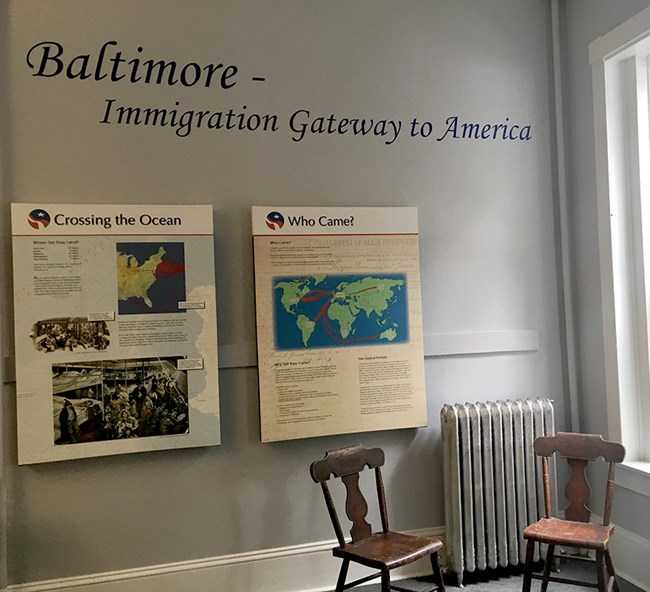Last updated: December 22, 2021
Article
Baltimore Immigration History Featured on Podcast Series
November 1, 2018 || Posted by: F. Calarco (NERO) –
The Baltimore National Heritage Area worked with the NPS Northeast Regional Office to produce a series of podcast episodes on Baltimore’s immigration history. A panel of speakers gathered at the Baltimore Immigration Museum to discuss how German, Irish, Jewish, and Italian immigrants, as well as African Americans, moved to Baltimore in the 1800s and described how each played a unique role in shaping the city. In the 19th century Baltimore was the second largest immigration hub on the east coast.
One of the roles of Baltimore National Heritage Area is to explore and interpret the history of the city, and they accomplish this by providing technical assistance and grants to local non-profit groups like the Baltimore Immigration Museum (BIM). The museum is in the historic German Immigrant House on Beason Street, which once provided temporary housing for 3,000 immigrants who arrived at Locust Point before 1904. The museum’s exhibits depict national immigration trends, as well as the stories specific to Baltimore.

Right Image: This house is now the Baltimore Immigration Museum.
Baltimore Immigration Museum
The first episode of the Baltimore podcast series features Nick Fessenden, Historian at the Baltimore Immigration Museum. He discusses the history of German immigrants, the largest group to arrive in Baltimore in the 1800s. Germans first arrived in Baltimore in the 18th century, and established the Zion Lutheran Church in 1755. Many arriving from Germany came to seek economic opportunities as craftsmen, carpenters, and masons. One notable immigrant was Ottmar Mergenthaler, and inventor who developed the linotype machine, the first device which could easily and quickly set complete lines for use in printing presses. This machine revolutionized the art of printing.
In episode two, Conor Donnan, a Board Member of the Irish Railroad Workers Museum, provided insights on Irish immigration into Baltimore in the 1800s. The word “Baltimore” itself is an Anglicized version of the Irish name meaning, “the town of the big house.” In addition to economic factors, following the Irish Potato Famine in the 1840s, many Irish immigrants began moving to America to seek work on the canals and railroads. One notable immigrant who arrived in Baltimore was John Crawford, who was one of the first people to introduce the small pox vaccine into the U.S., and helped to found the Maryland Medical School.

Baltimore Immigration Museum
In the 1800s as immigrants were arriving from overseas, so too were free blacks moving into Baltimore. Profressor Brewer of Morgan State University discussed the complexities of the African American diaspora as it pertained to Baltimore. With changes in the production economy, as well as Maryland’s liberalization of the manumission laws in the late 18th century, there were more free blacks than enslaved blacks living in Baltimore during this period. This was prior to the abolition of slavery, and made Baltimore unique compared to cities in both the North and South. Free blacks moving into Baltimore established institutions, including schools and churches. One notable historical figure who lived and worked in the community was Frederick Douglass.
In the third podcast episode, Independent Historian Deborah Weiner provided information on the different waves of Jewish immigration from Germany and Eastern Europe during the 1800s and 1900s. Similar to the Irish, Jewish immigrants arrived in Baltimore hoping for economic opportunity and religious freedom. The first wave of Jewish immigrants arrived from Germany in the mid-1800s, and many became successful garment factory owners. From the 1880s to the 1920s, a second wave arrived from Eastern Europe. Many of these immigrants worked in the German Jewish-owned factories, which created a complicated relationship. The third wave arrived in the 1930s escaping Nazi Germany, and included Gustav Brunn who would go on to invent the iconic Old Bay Seasoning, still used today when cooking seafood.
The mid-1800s also saw the beginning of Italian immigration into the city of Baltimore. This included people moving from southern Italy, and they arrived in Baltimore seeking economic opportunities like the groups that came before them. Native Baltimorean and well-known author Rafael Alvarez spoke of how Little Italy developed in the area that now encompasses the Baltimore Inner Harbor. He also discussed how the neighborhood has transformed over the years.

NPS Photo / F. Calarco
Different circumstances were at the root of each wave of immigration, but many commonalities emerged as the panelists presented their different perspectives at the Baltimore Immigration Museum. Each group of immigrants arrived in Baltimore to seek economic opportunity, and in most cases experienced some form of strife. German and Italians commonly Anglicized their names to avoid ethnic discrimination. Irish and African American workers were often pitted against each other by employers to prevent worker’s solidarity. The mid-1800s also saw the rise of the Know Nothing Party, an anti-immigration political party. Despite these obstacles, the different groups who moved into Baltimore also shared the experiences of perseverance, to make better lives for themselves and their families. Their contributions also made Baltimore a better place, and the city that it is today.
To learn more, listen to all three episodes about Baltimore’s immigration history in Season 2 (2018) of the NPS National Heritage Areas Podcast.
Return to 2018 NHA Blog
Tags
- baltimore national heritage area
- baltimore immigration museum
- public history
- immigration
- immigration history
- nha blog
- nha blog 2018
- national heritage areas program
- podcasts
- jewish history
- italian heritage
- irish-american heritage
- german american heritage
- african american history
- migration and immigration
- european american heritage
